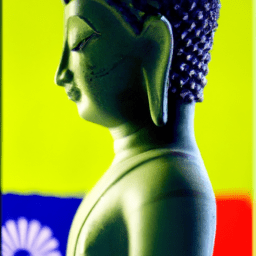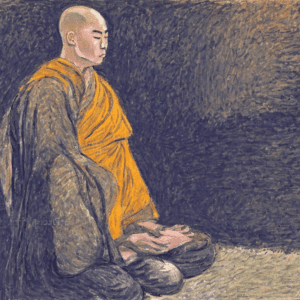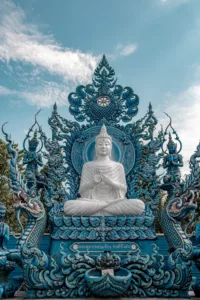| 4 Foundations of Mindfulness | |||
| English | Sanskrit | Pali | Approach |
| mindfulness of body | kāya-smṛti | kāyagatā-sati | Analyze body and develop non-attachment |
| mindfulness of feelings | vedanā-smṛti | vedanā-sati; | differentiate sensory / spiritual & cut craving link |
| mindfulness of mind | citta-smṛti | citta-sati | Cultivate wholesome thoughts, then analyze meditative ability |
| mindfulness of dhammas | dharma-smṛti | dhammā-sati | Understanding the causes of liberation |

Table of Contents

4 Foundations of Mindfulness in Buddhism, satipattana
The four components of mindfulness are body, feelings, mind, and dharmas. The vipassana movement in Theravadan dharma stems from the Satipattana Sutra. While often used in the West to deepen or approach meditation per se, The Buddha originally taught it to apply to all aspects of life. Sati mindfulness broadly spanned any activities, especially the classic four – walking, sitting, eating, and sleeping.
The 4 foundations of mindfulness can well be applied in the Western fashion, however, to deepen shamatha meditation and utilize it to primarily perceive egolessness or not-self.
Though this post uses some Pali words, the 4 foundations of mindfulness are explained in plain English. The mindfulness principles are covered in a fashion to help people actually meditate.
W
Mindfulness of Body, kayagata-sati
Mindfulness of body in formal meditation would include attention to the position of the body, bodily sensations, movements, aches and pains, and maintaining a neutral equanimous attitude towards them. It would also include mindfulness of breathing and feeling the integration of breath and body. Kyagata-sati could almost be called mindfulness of breath.
This can be done in multiple ways. A simple method is to focus on the breath as it exits the nostrils. This tight focus allows one to attain an initial form of one-pointedness, an early concentration. Using this with breath-counting cycles, the 3rd or 4th stage of the 9 stages of shamatha can be accomplished quickly. This will require a bit more understanding and proper motivation, however.
Until the mind is stably resting on the object, it’s not really meditation. This is why meditation seems so disagreeable to so many people. They don’t understand what it is.
satipatthana and Anapanasati: Mindfulness of Breathing Benefits
For the 4 foundations of mindfulness, anything can be used as an object of meditation, but here we use the breath. The breath carries multiple benefits. The breath is not a physical object. In this way, the meditator does not reify solidity, creating more materiality and permanence when the point of the dharma is the opposite. The breath as a meditation eases the mind and teaches it impermanence and the evanescent nature of all phenomena.
This shows the mind the karmic interdependence of things rather than the things in isolation. The breathing is both the same and changing. It is the same by being a constant in our experience. We will always need to breath continuously as long as we live. It’s a convenient object, it is always with you.
The changing nature of the breath is a meditative instruction. You teach yourself impermanence as it goes out, reverses, goes back in, and so forth. The sense of constancy that it is always there allows for stabilizing the mind and the sense of perpetual change teaches the mind about reality. This unifies shamatha and vipashyana.
How to meditate like a yogi
and enter profound samadhi
With nothing to grasp onto, it’s difficult to grasp too tightly onto the breath. At the same time, meditation on the breathing can be expanded to a remarkable degree. Consider the expansion and contraction of the lungs, the movement of the diaphragm, the integration of air into the blood flow and out to the cells, the body’s overwhelming desire for air (try doing without it for long), and the passage of air through the nasal passages.
Mindfulness of body can also be called awareness of body. This is also called seshin, a generalized awareness of phenomena. It’s not the deeper awareness of the nature of mind, but just sensing things as they occur. It’s not a single-pointed mindfulness, but a diffuse mindfulness, a sense of the body and mind as they are, feeling the entire environment. At the same time, the mindfulness focuses closely on the breath.
Satipattana Sutta speaks of the establishment of mindfulness. Body is a sort of basis for this. Part of it is also knowing the pains and subtle sensations of the body. Feel the position of the body and make slight adjustments to balance comfort with wakefulness.
Sati-kayagata can include the composite elements of the body, as well. Feel, or be aware of, the solidness, the earthy element, the cohesion or water element, the movement or air element, and the heat or fire element.
It also refers to the various pieces of the body – hands, feet, legs, arms, head, chest, belly, genitalia, etc. Spending time feeling these things, the power of the chest, the mobility of the arms, the vulnerability of the belly, and the dominance of the head, puts you in touch with your physicality in a way that most people lack. It’s very powerful.
Leave your body as a corpse
Song of Machig Labdrom
Leave it without any owner
Leave your mind as space
Leave it with no reference point
Finally, the body is seen as a corpse. This helps with knowing
- the body is not the self
- Life is impermanent
- Attachment to the body can be released
In the end, sati-kayagatha helps the practitioner to overcome attachment to this life. Detachment from the body brings the mind much closer to liberation, easing the time of death greatly and making true liberation possible.
Mindfulness of Feeling, vedanā-sati;
Also called mindfulness of life. This is the sati mindfulness of one’s raw existence as a living being. It dovetails nicely with breath because breathing is the fundamental trait of being alive. Mindfulness of life or feeling taps into one-pointed mindfulness of how you sustain your existence with the broader, more diffuse sense of being a living creature situated in the overall world.
Importantly, this is not a rehashing of one’s emotional content about specific issues. Those are set aside in meditation. However, it is about feeling two different things: material vs spiritual sensations and the ongoing reality of craving in the 12 nidanas.
The distinction between material and spiritual sensations allows the meditator to know whether they are on the correct approach to meditation or not. Spiritual sensory pleasure is hugely different from material sensory pleasure. It tends to be devoid of the 3 poisons: passion, aggression, and delusion. Notice and release the 3 poisons and cultivate meditative attainment as the general rule.
Second, release the craving embedded in the karmic structure. Craving is the key to overcoming rebirth as craving existence leads directly to rebirth. If you overcome it, then you get to choose how and when to take rebirth, if at all.
t
Mindfulness of Mind, citta-sati
Mindfulness of mind refers to the underlying state of the mind itself. Is the mind resting in a wholesome manner or in a degraded manner? Wholesomeness gives rise to peace and happiness, so the meditator who understands this and experiences it will guard this state.
Second and as important, citta-sati refers to the mind in meditation. Sati here notices if the mind is meditating properly or distracted, if torpor and excitement are rising, and engages them skillfully.
Generally taught as mindfulness of what is arising in the mind – not the very nature of mind, but the contents, citta-sati focuses on thoughts, even the most subtle, and how they occur. Thoughts are generally seen, in meditation, touched very lightly and released. They are not indulged. They are not continually recreated as is the common habit.
This training allows the person to release thoughts off of the cushion as well. This is especially helpful for people suffering from various mental obstacles such as anxiety or depression.
Mindfulness of dhamma, dhammā-sati
Mindfulness of dharma, or dhamma, means sati mindfulness of 2 possible things:
- phenomena
- the Noble truths of reality, Buddha’s perceived truths
Mindfulness of dharma as phenomena means simply abiding in the present moment. Feel the wind, the warmth or cold, the presence of others, the sounds outside, the light, and any movements in a generalized way. Just be aware of phenomena without analysis or judgment.
S
Mindfulness of dharma also refers to knowing the truths of the Buddha – non-self, emptiness, compassion, and so forth. It means to maintain a sense of staying on the path.
Generally, this would target the Hinayana, but would also apply to the other yanas. It is less emphasized in the Maha and Vajrayana. It’s more or less taken for granted as proficiency.

Flow, the profound mental state, also called Peak Performance, can be attained with meditation and can be ‘triggered’ at will, with enough discipline. Guide to Flow Mastery will teach you how.
4 Foundations of Mindfulness summary according to Trungpa
The modern teacher Chokyi Gyatso, Rinpoche taught a different translation of the 4 foundations. He emphasized simplicity to them, rather than too many confusing factors. The order is different, as well.
| Mindfulness of Body | Similar to the above, solidness and being |
| Mindfulness of Life | Life force itself |
| Mindfulness of Effort | The ‘flash’ or return to the present moment based on ongoing discipline |
| Mindfulness of Mind | Singular instants of consciousness, focus |
Trungpa’s teaching of mindfulness of effort is helpful in noting that the return to the present moment has value. This mindfulness means that you are making an overall effort in terms of study and practice, attempting to determine the nature of reality and work with the mind. Trying to meditate better.
When you sit, you might drift off, then suddenly, you remember the object and that you are meditating, rather than planning a vacation. You recall that you are putting in effort to that moment coming back to nowness is meaningful.
The actual return is effortless. But the preparation of the mind to recognize that value in the return is the challenge. There is a sense of appreciating the discipline.
What is important is imbuing the present moment with meaning. You are no longer lost in memory or fantasy of past and future but are rooted in the body, synchronized with nowness. This is an excellent method to accumulate merit by turning meditation into a positive thing.
faq
What are the 4 principles of mindfulness?
The 4 principles of mindfulness are:
Mindfulness of Body
Mindfulness of mind
Mindfulness of feeling
Mindfulness of dharma
Where would you find the Four Foundations of Mindfulness?
You would find the 4 foundations of mindfulness in the Satipattana Sutra.
What are the 4 foundations of mindfulness in Buddhism?
The 4 foundations of mindfulness in Buddhism are mindfulness of:
body, called Sati-kayagatha
feelings, called vedanā-sati
Mind, called citta-satti
and dharma, truth or phenomena, dhamma-sati
Conclusion – Four foundations of mindfulness review
Studying and memorizing the 4 Foundations of mindfulness in Buddhism using a simple form will be very helpful in meditation. Applying it in a balanced manner, working on mindfulness of body for a few sessions and gaining proficiency, then moving on to feelings, then mind, then mindfulness of dhammas, leads to one-pointedness.
Trying to do it all at once will make meditation fragmented, so work on one thing at a time until it becomes habituated. The goal is not to constantly think about applying the 4 foundations of mindfulness, but to automate them. You don’t have to think about it but simply do it.
Apply each foundation subtly in order to develop strength. Apply it on an intuitive and instinctive basis after mastering each aspect so the response is appropriate.
The companion to the 4 foundations of mindfulness is the 9 stages of resting the mind which is the map to deepen meditation so that it becomes strong and stable. The 4 foundations is like the car you drive, and the 9 stages are the road you drive on.

May all beings be happy
May all beings be peaceful
May all beings be safe
May all beings awaken to the light of their true nature
May all beings be free








